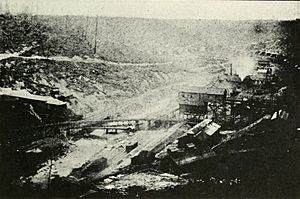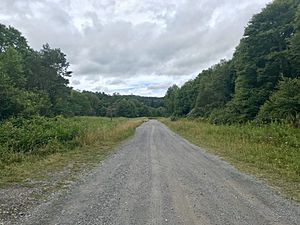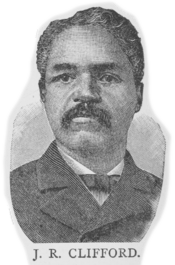Carrie Williams facts for kids
Caroline "Carrie" M. Williams (born Edwards, around 1866 – January 22, 1930) was an African-American teacher in West Virginia. She is famous for winning an important civil rights case in 1898, called Williams v. Board of Education of Fairfax District. This case helped make sure that schools in West Virginia had equal terms for all students, no matter their race. It also made sure that teachers were paid the same, regardless of their race.
Carrie Williams was born in Chillicothe, Ohio, around 1866. She taught school in both Ohio and West Virginia. In 1889, she married Abraham L. Williams, a coal miner. In 1892, she started teaching at the Coketon Colored School in Coketon, West Virginia.
For the 1892–1893 school year, the school board decided that white schools would be open for eight months, but the Coketon Colored School would only be open for five months. J. R. Clifford, West Virginia's first African-American lawyer, told Carrie Williams to teach for the full eight months. He then advised her to sue the school board for the extra three months of pay.
When the school year ended in June 1893, Williams asked the school board for her pay for the last three months. Clifford then filed a lawsuit for her. A jury in Tucker County agreed with Williams. The school board appealed the case to the Supreme Court of Appeals of West Virginia. In November 1898, the Supreme Court also ruled in Williams' favor. After this, Williams and her younger children moved to Chicago, where she passed away in 1930.
Quick facts for kids
Carrie Williams
|
|
|---|---|
| Born |
Caroline M. Edwards
circa 1866 Chillicothe, Ohio, U.S.
|
| Died | January 22, 1930 (aged 63–64) |
| Occupation | Educator |
| Known for | Plaintiff in Williams v. Board of Education of Fairfax District (1896) |
| Spouse(s) | Abraham L. Williams |
| Children | 9 |
Contents
Carrie Williams' Early Life and Teaching Career

Carrie Edwards was born in Chillicothe, Ohio, around 1866. Her parents, Jacob and Rachel Edwards, were both from Virginia. Carrie first taught school in Ohio. Later, she moved to West Virginia and continued her teaching career there. On November 20, 1889, she married Abraham L. Williams in Thomas. Abraham was a coal miner.
Carrie and Abraham Williams had nine children: May, Nevada, Robert, Russell, Irving, Ethel, Josephine, Juanita, and Wendell Phillips.
In 1892, when Carrie was 26 and expecting her third child, she was hired by the Board of Education of Fairfax District. She became a teacher at the two-room Coketon Colored School in the mining town of Coketon. Coketon was a busy coal mining community. It was founded by the Davis Coal and Coke Company to produce coke, which is a type of fuel, for nearby coal mines. Many timber workers and coal miners moved to Tucker County, where Coketon is located. This caused the county's population to double between 1890 and 1900. The number of African-American residents also grew, with most of them living in Coketon.
The Fight for Equal Schools
Why the School Board Created Unequal Terms

The people living in Tucker County's Fairfax District voted for schools to be open for eight months. However, the school board decided something different. They set the school term for white schools at eight months. But for the Coketon Colored School, they made the term only five months long. The school board shortened the term to save money. They also thought that fewer African-American students would enroll in the district's schools.
For the 1892–1893 school year, the school board offered Carrie Williams a five-month contract. She refused to sign it, even though they asked her many times. Even without a signed contract, the school board allowed Williams to teach for five months.
J. R. Clifford, West Virginia's first African-American lawyer, gave Williams important advice. He told her to teach at the Coketon Colored School for the full eight months. Then, he advised her to sue the school board for her wages for the three extra months. Clifford also told her to send the school board a bill for these months. If they refused to pay, he would file a lawsuit for her.
Clifford knew that Judge Joseph Thatcher Hoke, who would hear the case, supported African-Americans. Judge Hoke had helped Storer College, a school for African-American students. He also let teachers who taught formerly enslaved people stay at his home.
After the five-month term for African-American students ended, the school board told Williams to close the Coketon Colored School. However, the white schools remained open. Williams refused to close her school. With the support of the African-American parents in Coketon, she kept the school open for the additional three months. She received her salary for the first five months. But she was not paid for the remaining three months.
When the school year ended in June 1893, Williams gave the school board a bill for her final three months. This pay totaled $120. The board also took $1 from her pay for not turning in a report. The school board refused to pay Williams. They said she had continued to teach even though she knew she had been offered a five-month contract.
The Lawsuit and Appeals
On June 30, 1893, J. R. Clifford and another important lawyer, Alston G. Dayton, filed a lawsuit for Williams. They sued the Board of Education of Fairfax District in Tucker County. In November, Clifford officially sued the Fairfax District school board for the $120 Williams was owed, plus the $1 they had held back.
The case went to court in March 1894. Clifford argued that West Virginia state law required equal school terms for both white and African-American children. Because of this, he said Williams was owed her salary for the extra three months. The lawyers for the school district argued that Williams should not be paid for those three months because she did not have a written contract.
Judge Hoke oversaw the court proceedings. The jury decided in Williams' favor. Judge Hoke ordered the school board to pay Williams $139. This amount included interest and the cost of her legal fees. The school board then appealed the case to the Supreme Court of Appeals of West Virginia.
On June 11, 1898, the case was presented to the Supreme Court. On November 16, 1898, the Supreme Court agreed with the first court's decision. They again ruled in Williams' favor. Clifford and Dayton represented Williams at the Supreme Court. The Supreme Court's decision confirmed West Virginia's law that required equal school terms. It also set a rule for equal pay for teachers, no matter their race.
Justice Marmaduke H. Dent wrote in the Supreme Court's decision: "Treating colored people unfairly just because of their color, when it comes to rights and equal legal protection, is against public rules and the law of the land. If any difference in education should be made, it should help, not hurt, colored people."
This case was very important. According to historians Henry Louis Gates Jr. and Evelyn Brooks Higginbotham, it was one of the first cases in the South to say that treating people differently based on their color was against the law. This ruling also helped attract highly educated teachers to West Virginia. It also encouraged nearby states to offer equal pay for teachers.
Later Life and Legacy
Carrie Williams' husband, Abraham, passed away in 1913. Her daughter Nevada died in 1918 during the influenza pandemic. Williams and her younger children then moved to Chicago to be with her older children. Carrie Williams died in Chicago on January 22, 1930.

In 2011, Carrie Williams and her important case were honored with a highway historical marker. This marker is located at the Tucker County Courthouse in Parsons. It says:
In 1892, Coketon Colored School teacher Carrie Williams sued the local school board for equal pay. She was represented by the first African American lawyer in WV, J. R. Clifford, in front of Judge Hoke. Local jury found for her and she won appeal at WV Supreme Court. This early civil rights case affirmed equal school terms for African Americans in WV.
Also in 2011, another historical marker for the Coketon Colored School was put up near Thomas. This marker also mentions Williams. It says:
Segregated school located along North Fork of the Blackwater that served Coketon, center of coal and coke empire of H. G. Davis. In 1892 teacher Carrie Williams, represented by J. R. Clifford, state's first African American lawyer, sued when county reduced school's term. She won equal pay and terms for black students in WV. School closed in 1954.
In 2020, artist Alison "Ali" Printz created a large mural of Carrie Williams. The mural is 21 feet by 17 feet. It is on the back of the Buxton and Landstreet Gallery and Studios in Thomas, facing the Blackwater Canyon Trail.


